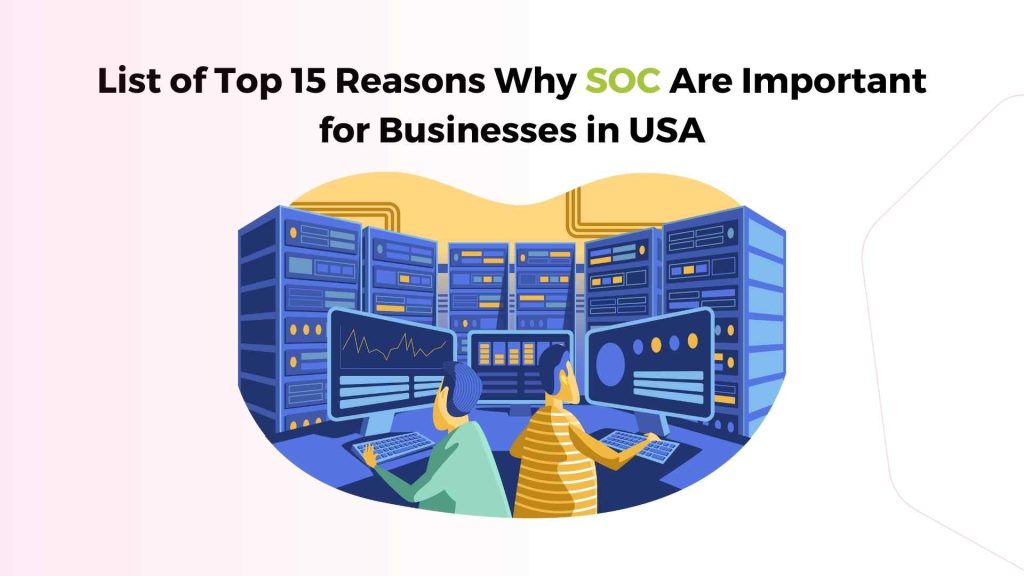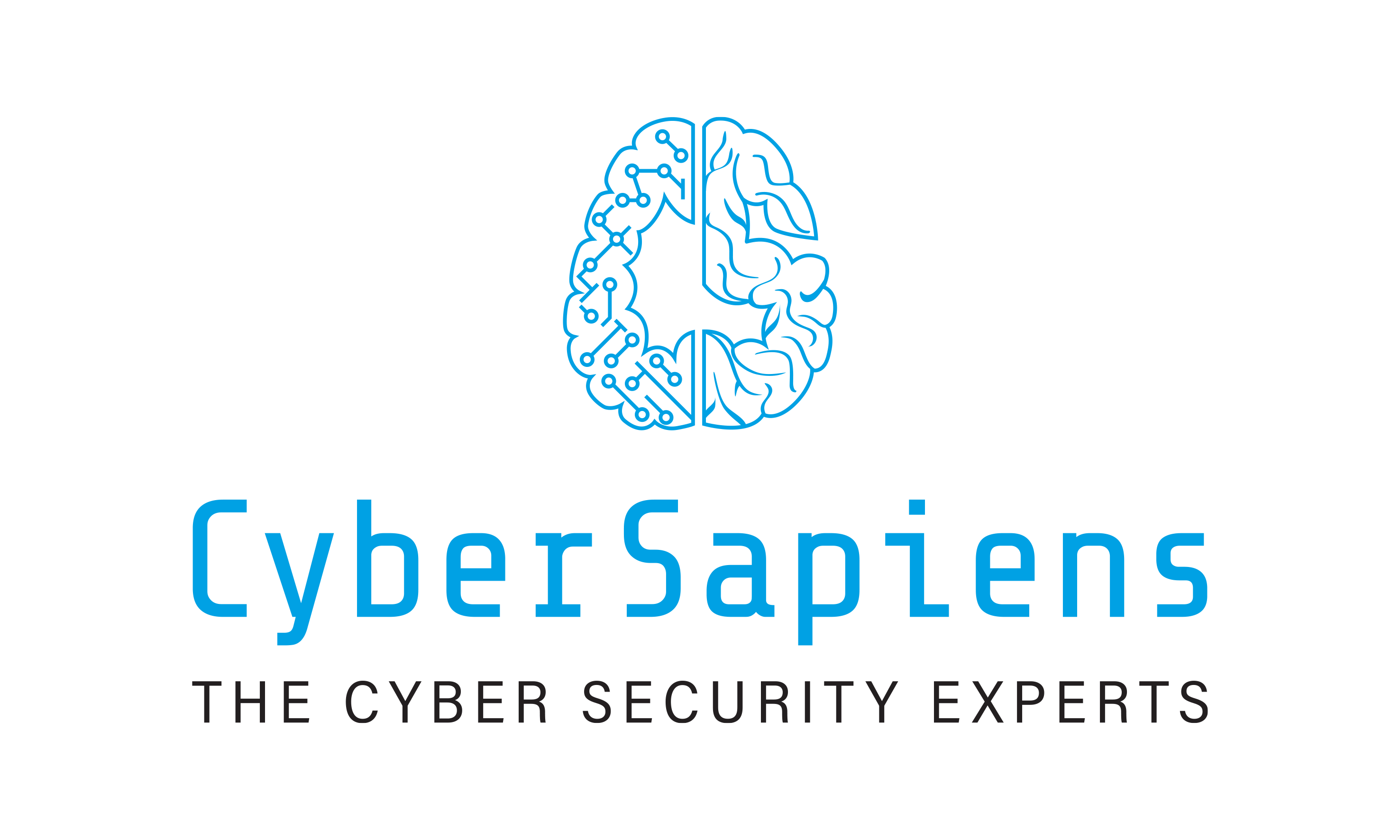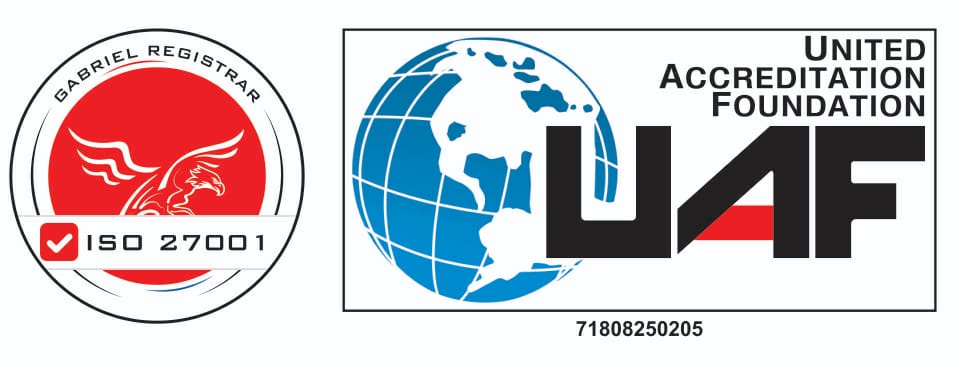Businesses in the United States face numerous cybersecurity threats that can compromise their sensitive data, disrupt operations, and damage their reputation.
A Security Operations Center (SOC) services is a dedicated facility that houses an information security team responsible for monitoring and analyzing an organisation’s security-related data to identify potential cybersecurity threats.
In this article, we will explore the Top 15 Reasons Why Security Operations Center Services are Important for Businesses in the United States.
List of Top 15 Reasons Why Security Operations Center (SOC) Services are important for Businesses in the United States

1. Enhanced Incident Detection and Response
SOC services provide around-the-clock monitoring of an organization’s network and systems to detect potential security threats. This enables businesses to respond quickly and effectively to incidents, minimizing the impact on operations and reducing the risk of data breaches.
With a SOC, organizations can identify and respond to security incidents more efficiently, reducing the mean time to detection (MTTD) and mean time to resolution (MTTR).
2. Advanced Threat Detection
SOC services utilize advanced threat detection tools, such as intrusion detection systems (IDS) and security information and event management (SIEM) systems, to identify potential security threats in real time.
These tools can detect anomalies in network traffic and system behaviour, enabling the SOC team to take proactive measures to prevent security breaches.
3. Compliance with Regulatory Requirements
Businesses in the United States must comply with various regulatory requirements, such as the Payment Card Industry Data Security Standard (PCI DSS), the Health Insurance Portability and Accountability Act (HIPAA), and the General Data Protection Regulation (GDPR).
SOC services can help organizations demonstrate compliance with these regulations by providing evidence of security controls and incident response procedures.
4. Real-time Threat Intelligence
SOC services provide real-time threat intelligence to help organizations stay ahead of the latest security threats. The SOC team can analyze threat data from various sources, including open-source intelligence and private threat intelligence feeds, to gain insights into emerging threats and vulnerabilities.
5. Improved Risk Management
SOC services can help organizations identify and mitigate potential security risks by providing risk assessments and vulnerability scans. This enables businesses to prioritize security efforts and allocate resources more effectively to address the most critical security risks.

6. Scalability and Flexibility
SOC services can be scaled to meet the evolving security needs of an organization. As businesses grow or change, their SOC services can be adjusted to accommodate new security requirements, providing flexibility and adaptability in an ever-changing security landscape.
7. Expertise and Knowledge
SOC teams consist of experienced security professionals with expertise in various areas of cybersecurity, including incident response, threat intelligence, and security analytics. This expertise can be invaluable to organizations that lack in-house security expertise or resources.
8. Cost Savings
SOC services can help organizations reduce costs associated with security incident response, such as the cost of lost productivity and reputational damage. By detecting and responding to security incidents quickly and effectively, SOC services can minimize the financial impact of security breaches.
9. Integration with Existing Security Tools
SOC services can be integrated with an organization’s existing security tools, such as firewalls, intrusion detection systems, and security information and event management (SIEM) systems.
This enables the SOC team to have a comprehensive view of the organization’s security posture, facilitating more effective incident detection and response.
10. Enhanced Security Posture
SOC services can help organizations improve their overall security posture by providing recommendations for security improvements and best practices. This enables businesses to strengthen their security defences and reduce the risk of security breaches.

11. Continuous Monitoring
SOC services provide continuous monitoring of an organization’s security posture, enabling the SOC team to detect potential security threats in real-time. This continuous monitoring can help organizations stay ahead of emerging security threats and vulnerabilities.
12. Adherence to Security Best Practices
SOC teams adhere to security best practices and industry-leading standards, ensuring that organizations receive high-quality security services. This enables businesses to trust their SOC services to protect their sensitive data and systems.
13. Enhanced Communication
SOC services provide clear and timely communication of security incidents and events to stakeholders, including IT teams, management, and executives. This enables organizations to respond quickly and effectively to security incidents, minimizing the impact on operations.
14. Customized Security Solutions
SOC services can be customized to meet the unique security needs of an organization. This enables businesses to receive tailored security solutions that address their specific security requirements and concerns.
15. Optimal Use of Resources
SOC services enable organizations to optimize their use of resources by leveraging the expertise and knowledge of the SOC team. This allows businesses to focus on core operations while the SOC team handles security-related tasks.
Best Practices for Implementing a SOC Service

Implementing a Security Operations Center (SOC) service is a critical step in protecting your organization’s assets from cyber threats. Here are the key steps to follow:
1. Identify Your Security Needs
First, you need to understand the specific security threats and risks facing your organization. This will help you determine the level of security maturity required to mitigate these risks.
2. Choose a Reputable SOC Service Provider
Next, you need to research and select a reputable SOC service provider that can meet your organization’s specific security needs. This provider should have the necessary expertise, resources, and technology to support your organization’s security needs.
3. Implement Incident Response and Communication Plans
Develop an incident response plan and communication strategy to ensure that your organization can respond effectively to security incidents. This includes defining the roles and responsibilities of the incident response team and establishing a communication strategy that ensures timely and effective communication during a security incident.
4. Continuously Monitor and Improve
Implement a continuous monitoring program to monitor your organization’s security posture in real time. This includes using various tools and techniques to monitor security event data, system logs, and network traffic to identify potential security threats. Continuously evaluate and improve the SOC service to ensure that it remains effective in detecting and responding to security incidents.
5. Implementation Timeline
The implementation of a SOC service typically takes several months, including researching and selecting a provider, implementing the service, and developing incident response and communication plans.
Summary
Here is the summary of the top 15 Reasons Why Security Operations Center Services are Important for Businesses in the United States.
- Enhanced Incident Detection and Response
- Advanced Threat Detection
- Compliance with Regulatory Requirements
- Real-time Threat Intelligence
- Improved Risk Management
- Scalability and Flexibility
- Expertise and Knowledge
- Cost Savings
- Integration with Existing Security Tools
- Enhanced Security Posture
- Continuous Monitoring
- Adherence to Security Best Practices
- Enhanced Communication
- Customized Security Solutions
- Optimal Use of Resources
Conclusion
Security Operations Center (SOC) services are a critical component of any robust cybersecurity strategy for businesses in the United States. By providing real-time threat detection and response, enhanced incident response, and compliance with regulatory requirements, SOC services help organizations protect themselves against emerging security threats.
With the threat landscape continuing to evolve, businesses need to invest in a reputable SOC service to ensure their security posture remains strong and resilient.
FAQs: Top 15 Reasons Why Security Operations Center Services are Important for Businesses in the United States
1. What is a Security Operations Center (SOC)?
Ans: A Security Operations Center (SOC) is a centralized unit that monitors and analyzes an organization’s security-related data to identify potential security threats and prevent security breaches.
2. Why do I need a SOC?
Ans: You need a SOC to protect your organization’s assets from cyber threats and ensure the security and integrity of your data. A SOC helps you detect and respond to security incidents in real-time, reducing the risk of data breaches and other security threats.
3. What are the benefits of implementing a SOC?
Ans: The benefits of implementing a SOC include improved security posture, reduced risk of data breaches, faster incident response, and compliance with regulatory requirements.
4. How do I choose a SOC service provider?
Ans: To choose a SOC service provider, research and select a reputable provider that has the necessary expertise, resources, and technology to support your organization’s security needs. Consider factors such as experience, reputation, and customer references.
5. What is the typical implementation timeline for a SOC?
Ans: The typical implementation timeline for a SOC is several months, including researching and selecting a provider, implementing the service, and developing incident response and communication plans.
6. What are the key components of a SOC?
Ans: The key components of a SOC include security information and event management systems, intrusion detection and prevention systems, vulnerability scanning and vulnerability management tools, and incident response and security operations teams.
7. How much does it cost to implement a SOC?
Ans: The cost of implementing a SOC varies depending on the size and complexity of your organization, as well as the level of security maturity required. The cost can range from tens of thousands to millions of dollars.
8. Do I need to have a dedicated team to manage my SOC?
Ans: Yes, you need to have a dedicated team to manage your SOC, including security analysts, incident responders, and security engineers. The team should have the necessary training, expertise, and resources to respond to security incidents effectively.
9. How often should I review and update my SOC?
Ans: You should review and update your SOC regularly to ensure that it remains effective in detecting and responding to security incidents. This includes monitoring security event data, system logs, and network traffic to identify potential security threats.
10. Is implementing a SOC a one-time process?
Ans: No, implementing a SOC is not a one-time process. It requires ongoing monitoring and improvement to ensure that it remains effective in detecting and responding to security incidents. Regular reviews and updates are necessary to stay ahead of emerging security threats.












